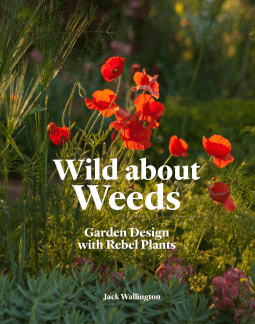
For the purpose of this book, I have defined a garden weed as ‘a plant that reproduces seemingly uncontrollably’.
Wild about Weeds by Jack Wallington
I loved this definition and swiftly warmed to Jack Wallington’s theme in Wild about Weeds! He goes on to speak of plants which, in South Africa, would be considered prized, sold in nurseries and shared amongst friends. I chuckled at the idea of them being considered a weed in a far more moist country like England. Some Weeds transcend continents and climate and enough of the principles of the books apply globally.
Weeds are unbelievably resilient, they have survival tactics that other plants should envy! This book drew my attention to their positive qualities. It should be admitted now that I’m not the weed-remover. Mum and Charles wrestle and remove those at which I point and exclaim “that shouldn’t be there” so I’m not sure they’ll appreciate my newfound admiration for these previously judged plants!
A plant is a plant and if you like it, you should grow it no matter what anyone else thinks or what label it’s been given. Labels are annoying. They’re often someone else’s opinion telling us what we should think. “Weed” being a good example – it is merely a broad and negative term associated with any plant that pops up where we weren’t expecting it. The label is a lie.
Wild about Weeds by Jack Wallington
Certain “Weeds” I gasped to hear called such, my beautiful foxgloves…never…my gorgeous flowing ivy…daisies…violas…oh no! And I reflected on this, I realised that’s the point of Jack’s book, to love those plants that you find attractive whether they grow voraciously or not! He makes several recommendations in the book to help limit the growth if the plant begins to escape its bounds. He shares wisdom on planning your layout to make the best of each plant. He inspires and encourages the gardener to observe, admire and shape one’s garden to one’s own tastes and I throughly enjoyed it from cover to cover.
I loved the interviews with key landscapers and garden aficionados included in the book, particularly the one on plant communities. I think this picture of plant communities is gorgeous “They’re social networks, densely layered, incredibly diverse and sophisticated in their interactions…Plants collaborate, compete and communicate with one’s another.”
Overall the book is a call to a new way of gardening, more in tune with the environment, more respectful of our resources and more accepting of all plants. If you love learning more about plants and are keen to explore new gardening methods, this is one for you! It’s five out of five on the en-JOY-ment scale and highly recommended.

From the back cover:
Wild About Weeds by RHS-qualified garden designer Jack Wallington is the first gardening book that looks again at garden design’s most ignored group of plants: weeds.
Not all weeds are ugly uncontrollable brutes. Yes, they can be difficult and intimidating, but weeds can bring a wild, rebellious element to a garden.
In his new book, Jack Wallington profiles over 50 weeds and demonstrates surprising ways to grow them. He explains every element of growing weeds in our own gardens, from weed hunting to collecting and storing weeds, and letting these wild plants flourish without taking control.
Wild About Weeds makes a compelling case for leaving weeds in gardens as part of planting schemes to help bring gardens to life and make them more sustainable and wildlife-friendly. Including a brief history of garden weeds, as well as exclusive interviews with top gardeners, designers and botanists,
Wild About Weeds is the must-have guide for anyone looking to tame and nurture the most challenging of plants.
I received a complimentary copy of the book from Laurence King Publishers through NetGalley. Opinions expressed in this review are completely my own.

